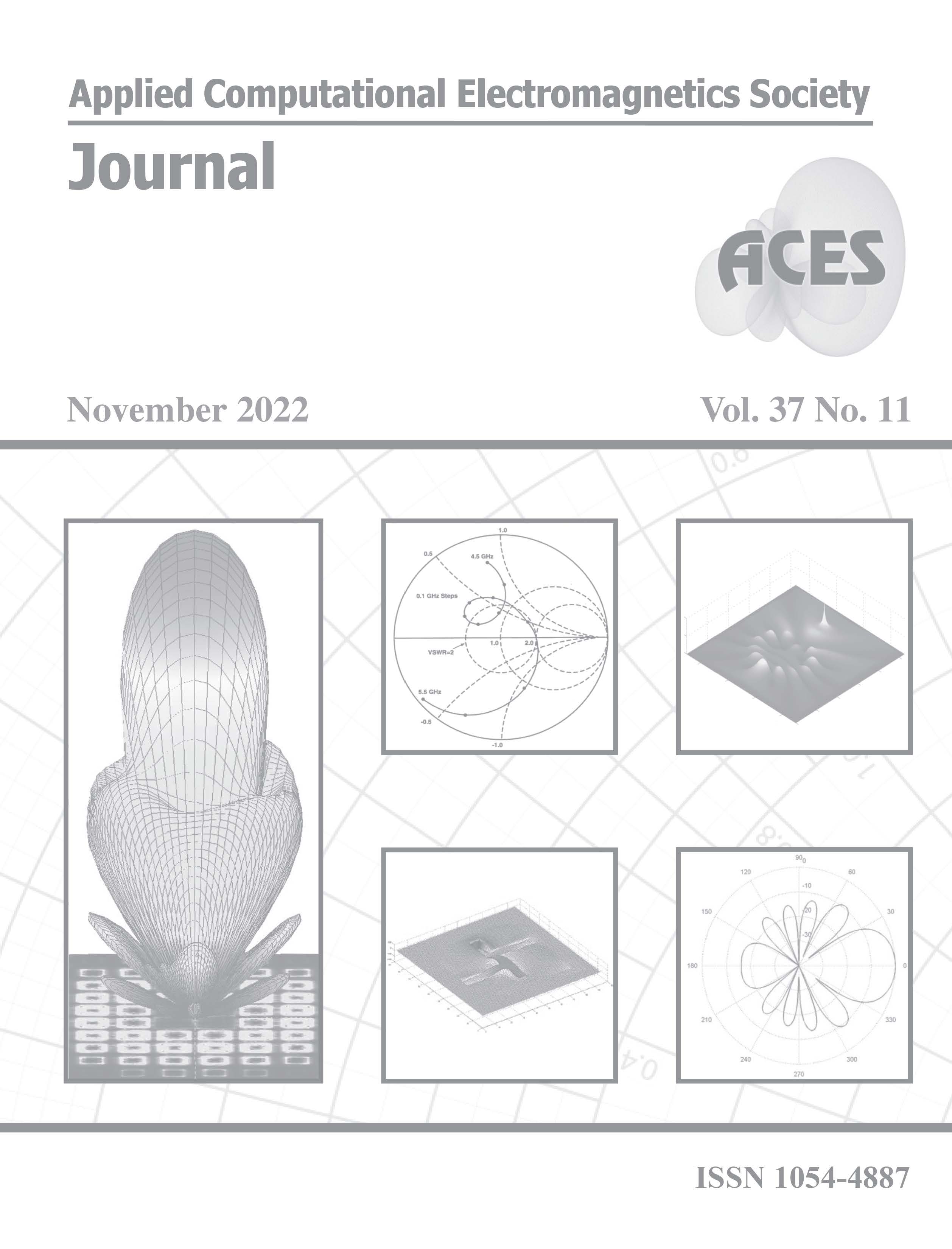Millimeter-wave Wideband High-isolation Antenna Array Based on End-fire Magnetoelectric Dipole Antenna for 5G Applications
DOI:
https://doi.org/10.13052/2022.ACES.J.371108Keywords:
fifth generation (5G), high-isolation, magnetoelectric (ME) dipole, wide-angle scanning, wide bandwidthAbstract
In this paper, a millimeter-wave (mmW) wideband high-isolation wide-angle scanning antenna is presented. The end-fire magnetoelectric (ME) dipole with wideband impedance characteristic and wide beamwidth is selected. Based on the ME dipole, a 1×4 subarray with a stripline feed network is constructed to get higher antenna efficiency. Then, four 1×4 subarrays are adopted to form a 4×4 array to realize the wide-angle scanning performance. Furthermore, to get better isolation between the subarrays, the beam is tilted on the non-scanning plane; in addition, the resonant split rings are added on the background of the subarrays. With these two measures, the isolation between the subarrays can be effectively reduced, with more than 20 dB over the entire bandwidth. Owing to the wide beamwidth of ME dipole and high isolation between the subarrays, the 4×4 array can obtain the wide-angle scanning characteristic. The final antenna covers an operating bandwidth of 19.5% (24.25-29.5 GHz) with return loss more than 10 dB, which can meet the band in the 5G standard. The beam can scan approximately ±55∘ with a realized gain reduction under 3 dB within the wide operating bandwidth. Also, the simulated radiation efficiency of the array is more than 77% over almost the entire band. The antenna will be a potential candidate to be applied in 5G applications.
Downloads
References
B. Yang, Z. Yu, Y. Dong, J. Zhou, and W. Hong, “Compact tapered slot antenna array for 5G millimeter-wave massive MIMO systems,” IEEE Trans. Antennas Propag., vol. 65, no. 12, pp. 6721-6727, 2017.
T. Li and Z. N. Chen, “Wideband sidelobe-level reduced Ka-band metasurface antenna array fed by substrate-integrated gap waveguide using characteristic mode analysis,” IEEE Trans. Antennas Propag., vol. 68, no. 3, pp. 1356-1365, 2020.
S. P. Dubazane, P. Kumar, and T. J. O. Afullo, “Metasurface superstrate-based MIMO patch antennas with reduced mutual coupling for 5G communications,” Applied Computational Electromagnetics Society (ACES) Journal, vol. 37, no. 4, pp. 408-419, 2022.
H. Zhu, Y. Qiu, J. Bai, and G. Wei, “Compact design of non-uniform meta-surface for patch antenna main beam steering,” Applied Computational Electromagnetics Society (ACES) Journal, vol. 34, no. 9, pp. 1300-1304, 2019.
D. Wang, H. Wong, K. B. Ng, and C. H. Chan, “Wideband shorted higher-order mode millimeter-wave patch antenna,” Proceedings of the 2012 IEEE International Symposium on Antennas and Propagation, pp. 1-2, 2012.
L. Lu, K. Ma, F. Meng, and K. S. Yeo, “Design of a 60-GHz Quasi-Yagi antenna with novel ladder-like directors for gain and bandwidth enhancements,” IEEE Antennas Wireless Propag. Lett., vol. 15, pp. 682-685, 2016.
Y. Li, L. Ge, J. Wang, S. Da, D. Cao, J. Wang, and Y. Liu, “3-D printed high-gain wideband waveguide fed horn antenna arrays for millimeter-wave applications,” IEEE Trans. Antennas Propag., vol. 67, no. 5, pp. 2868-2877, May 2019.
P.-Y. Feng, S.-W. Qu, X.-H. Chen, and S. Yang, “Low-profile high-gain and wide-angle beam scanning phased transmitarray antennas,” IEEE Access, vol. 8, pp. 34276-34285, 2020.
Z.-Y. Yu, Y.-H. Zhang, S.-Y. He, H.-T. Gao, H.-T. Chen, and G.-Q. Zhu, “A wide-angle coverage and low scan loss beam steering circularly polarized folded feflectarray antenna for millimeter-wave applications,” IEEE Trans. Antennas Propag., vol. 70, no. 4, pp. 2656-2667, 2022.
Y. Ding, S. Hou, and G. Yang, “Wide-angle scanning dielectric resonator antennas for millimeter-wave applications,” International Symposium on Antennas and Propagation (ISAP), pp. 1-2, 2021.
Z. Qu, S. -W. Qu, Z. Zhang, S. Yang, and C. H Chan, “Wide-angle scanning lens fed by small-scale antenna array for 5G in millimeter-wave band,” IEEE Trans. Antennas Propag., vol. 68, no. 5, pp. 3635-3643, 2020.
Y. Ye, Z. Y. Huang, Y. Jiang, L.-A. Bian, C. Zhu, J. J. Huang, and N. C. Yuan, “A wideband and wide scanning tightly coupled dipole array with meta-surface wide-angle impedance matching,” Applied Computational Electromagnetics Society (ACES) Journal, vol. 36, no. 7, pp. 872-878, 2021.
Z. Zhao, Y. Zhu, and C. Deng, “Microstrip phased array antenna with small element space for 5G millimeter-wave applications,” IEEE 3rd International Conference on Electronic Information and Communication Technology (ICEICT), pp. 620-622, 2020.
S. Pan, W. Yang, W. Che, and Q. Xue, “Millimeter-wave wide-angle scanning phased array based on low-profile wide-beam patch antenna element,” IEEE MTT-S International Wireless Symposium (IWS), pp. 1-3, 2020.
Z.-F. Yuan and Z.-H. Tu, “Wideband ±
∘
dual-polarized millimeter-wave antenna array with wide-angle scanning performance,” International Conference on Microwave and Millimeter Wave Technology (ICMMT), pp.1-3, 2021.
M. K. Ishfaq, T. Abd Rahman, M. Himdi, H. T. Chattha, Y. Saleem, B. A. Khawaja, and F. Masud, “Compact four-element phased antenna array for 5G applications,” IEEE Access, vol. 7, pp. 161103-161111, 2019.
Y. Feng, J.-Y. Li, L.-K. Zhang, X.-J. Yu, Y.-X. Qi, D. Li, and S.-G. Zhou, “A broadband wide-angle scanning linear array antenna with suppressed mutual coupling for 5G sub-6G applications,” IEEE Antennas Wireless Propag. Lett., vol. 21, no. 2, pp. 366-370, 2022.
X. Dai, A. Li, and K. M. Luk, “A wideband compact magnetoelectric dipole antenna fed by SICL for millimeter wave applications,” IEEE Trans. Antennas Propag., vol. 69, no. 9, pp. 5278-5285, Sep. 2021.
Z. Tang and Y. Dong, “A Ka-band antenna array based on wide-beamwidth magnetoelectric dipole,” IEEE Antennas Wireless Propag. Lett., vol. 21, no. 3, pp. 501-505, 2022.
J. Zeng and K. Luk, “Wideband millimeter-wave end-fire magnetoelectric dipole antenna with microstrip-line feed,” IEEE Trans. Antennas Propag., vol. 68, no. 4, pp. 2658-2665, Apr.2020.
Z. Zhou, S. Yang, and Z. Nie, “A novel broadband printed dipole antenna with low cross-polarization,” IEEE Trans. Antennas Propag., vol. 55, no. 11, pp. 3091-3093, Nov. 2007.




